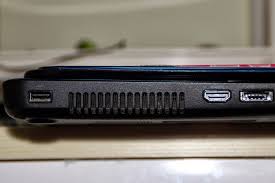While laptops are faster and sleeker than ever before, the increasing demands we place on modern machines can lead to overheating. This has the potential to seriously affect your machine’s long-term performance and, in a worst-case scenario, even fry your beloved components.
The likelihood of your laptop overheating will depend on what you’re using it for. Serious gamers demand higher performance from the CPU and are therefore more likely to encounter problems than those who solely use word processors. Thankfully, we’ve put together a handy guide with some quick and easy fixes to prevent overheating.
 Power = Heat
Power = Heat
The more electricity your laptop uses, the more heat it will produce. The following tips therefore focus on reducing the power output by tweaking your power settings and maintaining relevant hardware to ensure the fan is working optimally.
Hardware
- Vents
The vents on the bottom of your laptop are vital for sucking in cool air and preventing your motherboard from getting too hot. Clean them regularly to stop dirt from clogging the heat sink. For more information on keeping your tech clean, there are plenty of product guides (check out the manufacturer’s website) and cleaning tips online.
- Surface considerations
Do not rest your laptop on soft cushioned materials for extended periods of time. When using your computer on your lap, placing it on an empty cardboard box rather than your clothing can prevent spikes in temperature.
- Laptop cooling pad
For a sturdier and altogether more professional solution, consider investing in a laptop cooling pad. Simple but ingenious, most models plug snugly into your USB port and use built-in fans to draw more air into your machine, improving ventilation and temperature control.
Note: Before changing your settings, check your laptop’s temperature using third-party software (widely available online) as feeling the heat on the exterior alone isn’t a true test.
- Power-saving modes
As mentioned, the less electricity your laptop is using, the less heat it will produce. Stick to power-saving mode to reduce the chance of overheating. Some Apple products are set to ‘quiet mode’ as a default, which limits the fan and can lead to a rise in temperature.
- BIOS
Some PC laptops will allow you to access the BIOS and alter your T-MAX setting, the temperature at which your computer automatically turns off to avoid overheating. Finding a balance between temperature and performance can be a case of trial and error, so reduce the temperature incrementally
- Defragment your hard drive
Defragmenting your hard drive is a great way of reducing the amount of work it has to do to locate files, saving power and keeping your laptop cool.
Remember: If you suspect that your laptop has overheated, don’t be tempted to get out the screwdriver and attempt to fix things yourself. As well as likely voiding the warranty, home repair jobs can often do more harm than good. For more laptop maintenance and cleaning tips, check the manufacturer’s instructions and expert guides online.
